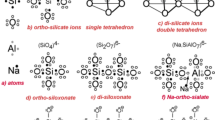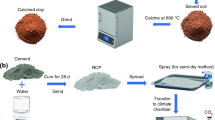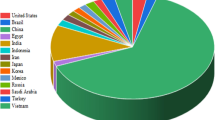Abstract
This work assessed the properties of the hydration processes and the strength development of synthesised belite cement samples. The belite clinker was synthesized in the high-temperature furnace by calcining the mixture of industrial waste (~ 18%) (granite cutting waste and silica-gel waste from AlF3 production) and natural raw materials (~ 82%) at 1150 °C temperature for 2 h. It was obtained that the produced binder was composed mainly of larnite, mayenite, srebrodolskite, ye`elimite, and gehlenite. Furthermore, the synthesized clinker was blended with gypsum (5–20%) to determine the required amount of gypsum additive for the hydration process. The results of microcalorimetry analysis showed that the amount of gypsum plays an important role in the hydration process because, in the samples with 5% or 7.5% of additive, two exothermic reactions were identified, while in the samples with a higher amount of additive 3–4 exothermic reactions were identified. The mechanical properties of prepared concrete were determined by curing the standard prisms (according to the standard of EN 196–1, cement/sand = 1:3, w/c = 0.67) in an aqueous (25 °C, for 3–90 days) or hydrothermal (90 °C, 125 °C, or 175 °C, for 24 h) environment. The results of a compressive test demonstrated that the curing method significantly affects the compressive strength development of produced belite concrete, and the highest value (> 18 MPa) was obtained after hydrothermal curing at 175 °C. The mineralogical composition of formed hydrates was determined by X-ray diffraction analysis and simultaneous thermal analysis.






Similar content being viewed by others
References
Andrew RM. Global CO2 emissions from cement production, 1928–2018. Earth Syst Sci Data. 2019;11:1675–710. https://doi.org/10.5194/essd-11-1675-2019.
Wei J, Cen K, Geng Y. Evaluation and mitigation of cement CO2 emissions: projection of emission scenarios toward 2030 in China and proposal of the roadmap to a low-carbon world by 2050. Mitig Adapt Strateg Glob Chang. 2019;24:301–28. https://doi.org/10.1007/s11027-018-9813-0.
Madlool NA, Saidur R, Hossain MS, Rahim NA. A critical review on energy use and savings in the cement industries. Renew Sustain Energy Re. 2011;15:2042–60. https://doi.org/10.1016/j.rser.2011.01.005.
Rahman A, Rasul MG, Khan MMK, Sharma S. Impact of alternative fuels on the cement manufacturing plant performance: an overview. Procedia Eng. 2013;56:393–400. https://doi.org/10.1016/j.proeng.2013.03.138.
Naqi A, Jang JG. Recent progress in green cement technology utilizing low-carbon emission fuels and raw materials: a review. Sustain. 2019;11(2):537. https://doi.org/10.3390/su11020537.
Sivakrishna A, Adesina A, Awoyera PO, Kumar KR. Green concrete: a review of recent developments. Mater Today Proc. 2020;27:54–8. https://doi.org/10.1016/j.matpr.2019.08.202.
Gartner E. Industrially interesting approaches to “low-CO2” cements. Cem Concr Res. 2004;34:1489–98. https://doi.org/10.1016/j.cemconres.2004.01.021.
Kotsay GN, Jaskulski R. Belite cement as an ecological alternative to Portland cement - a review. Mater Struct Technol J. 2019;2:70–6. https://doi.org/10.31448/mstj.02.01.2019.70-76.
Bullerjahn F, Zajac M, Ben HM. CSA raw mix design: effect on clinker formation and reactivity. Mater Struct Constr. 2015;48:3895–911. https://doi.org/10.1617/s11527-014-0451-z.
Pimraksa K, Chindaprasirt P. Sulfoaluminate cement-based concrete. In: Eco-Efficient Repair and Rehabilitation of Concrete Infrastructures. Elsevier; 2018. p. 355–85.
Hanein T, Galvez-Martos JL, Bannerman MN. Carbon footprint of calcium sulfoaluminate clinker production. J Clean Prod. 2018;172:2278–87. https://doi.org/10.1016/j.jclepro.2017.11.183.
Winnefeld F, Lothenbach B. Hydration of calcium sulfoaluminate cements-experimental findings and thermodynamic modelling. Cem Concr Res. 2010;40:1239–47. https://doi.org/10.1016/j.cemconres.2009.08.014.
Jansen D, Wolf JJ, Fobbe N. The hydration of nearly pure ye’elimite with a sulfate carrier in a stoichiometric ettringite binder system. Implications for the hydration process based on in-situ XRD, 1H-TD-NMR, pore solution analysis, and thermodynamic modeling. Cem Concr Res. 2020;127:105923. https://doi.org/10.1016/j.cemconres.2019.105923.
Allevi S, Marchi M, Scotti F, Bertini S, Cosentino C. Hydration of calcium sulphoaluminate clinker with additions of different calcium sulphate sources. Mater Struct. 2016;49:453–66. https://doi.org/10.1617/s11527-014-0510-5.
Winnefeld F, Martin LHJ, Müller CJ, Lothenbach B. Using gypsum to control hydration kinetics of CSA cements. Constr Build Mater. 2017;155:154–63. https://doi.org/10.1016/j.conbuildmat.2017.07.217.
Ioannou S, Reig L, Paine K, Quillin K. Properties of a ternary calcium sulfoaluminate-calcium sulfate-fly ash cement. Cem Concr Res. 2014;56:75–83. https://doi.org/10.1016/j.cemconres.2013.09.015.
Londono-Zuluaga D, Tobón JI, Aranda MAG, Santacruz I, De la Torre AG. Clinkering and hydration of belite-alite-ye´elimite cement. Cem Concr Compos. 2017;80:333–41. https://doi.org/10.1016/j.cemconcomp.2017.04.002.
Gartner EM, MacPhee DE. A physico-chemical basis for novel cementitious binders. Cem Concr Res. 2011;41:736–49. https://doi.org/10.1016/j.cemconres.2011.03.006.
Trauchessec R, Mechling JM, Lecomte A, Roux A, Le Rolland B. Hydration of ordinary Portland cement and calcium sulfoaluminate cement blends. Cem Concr Compos. 2015;56:106–14. https://doi.org/10.1016/j.cemconcomp.2014.11.005.
Tchadjié LN, Djobo JNY, Ranjbar N, Tchakouté HK, Kenne BBD, Elimbi A, et al. Potential of using granite waste as raw material for geopolymer synthesis. Ceram Int. 2016;42:3046–55. https://doi.org/10.1016/j.ceramint.2015.10.091.
Ramos T, Matos AM, Schmidt B, Rio J, Sousa-Coutinho J. Granitic quarry sludge waste in mortar: effect on strength and durability. Constr Build Mater. 2013;47:1001–9. https://doi.org/10.1016/j.conbuildmat.2013.05.098.
Joint-stock company Lifosa official website. http://www.lifosa.com/en/products-and-services. Accessed 2021 Sep 03.
Gautam L, Jain JK, Kalla P, Danish M. Sustainable utilization of granite waste in the production of green construction products: a review. Mater Today Proc. 2020;44:4196–203. https://doi.org/10.1016/j.matpr.2020.10.532.
Ghannam S, Najm H, Vasconez R. Experimental study of concrete made with granite and iron powders as partial replacement of sand. Sustain Mater Technol. 2016;9:1–9. https://doi.org/10.1016/j.susmat.2016.06.001.
Krivenko P, Vaičiukynienė D, Kantautas A, Vaitkevičius V, Šerelis E. Effect of AlF3 production waste on the processes of hydration and hardening of the alkali-activated Portland cement with sodium silicate hydrate. J Therm Anal Calorim. 2019;138:879–87. https://doi.org/10.1007/s10973-019-08086-y.
Kubiliute R, Kaminskas R. The pozzolanic activity of calcined clay - silica gel composites. Mater Sci. 2013;19:453–60. https://doi.org/10.5755/j01.ms.19.4.2300.
Baltakys K, Dambrauskas T, Rubinaite D, Siauciunas R, Grineviciene A. Formation and hydration of eco-friendly cement using industrial wastes as raw materials. Sci Rep. 2021;11:1–12. https://doi.org/10.1038/s41598-021-94148-x.
Gallardo M, Almanza JM, Cortés DA, Escobedo JC, Escalante-García JI. Synthesis and mechanical properties of a calcium sulphoaluminate cement made of industrial wastes. Mater Constr. 2014;64:e023. https://doi.org/10.3989/mc.2014.04513.
Chen IA, Juenger MCG. Synthesis and hydration of calcium sulfoaluminate-belite cements with varied phase compositions. J Mater Sci. 2011;46:2568–77. https://doi.org/10.1007/s10853-010-5109-9.
Bullard JW, Jennings HM, Livingston RA, Nonat A, Scherer GW, Schweitzer JS, et al. Mechanisms of cement hydration. Cem Concr Res. 2011;41:1208–23. https://doi.org/10.1016/j.cemconres.2010.09.011.
Brown P. Early-age cement hydration reactions. Transp Res Rec. 1990;1284:53–9.
Chindaprasirt P, Cao T. Setting, segregation and bleeding of alkali-activated cement, mortar and concrete binders. In: Handbook of Alkali-Activated Cements, Mortars and Concretes. Elsevier; 2015. p. 113–31. https://doi.org/10.1533/9781782422884.2.113.
Zhang J, Li G, Ye W, Chang Y, Liu Q, Song Z. Effects of ordinary Portland cement on the early properties and hydration of calcium sulfoaluminate cement. Constr Build Mater. 2018;186:1144–53. https://doi.org/10.1016/j.conbuildmat.2018.08.008.
Hargis CW, Lothenbach B, Müller CJ, Winnefeld F. Carbonation of calcium sulfoaluminate mortars. Cem Concr Compos. 2017;80:123–34. https://doi.org/10.1016/j.cemconcomp.2017.03.003.
Martin LHJ, Winnefeld F, Tschopp E, Müller CJ, Lothenbach B. Influence of fly ash on the hydration of calcium sulfoaluminate cement. Cem Concr Res. 2017;95:152–63. https://doi.org/10.1016/j.cemconres.2017.02.030.
Rungchet A, Poon CS, Chindaprasirt P, Pimraksa K. Synthesis of low-temperature calcium sulfoaluminate-belite cements from industrial wastes and their hydration: comparative studies between lignite fly ash and bottom ash. Cem Concr Compos. 2017;83:10–9. https://doi.org/10.1016/j.cemconcomp.2017.06.013.
Álvarez-pinazo G. Hydration of Belite-Ye’elimite-Ferrite (BYF) cements with different calcium sulfate sources. Adv in Cem Res. 2016;28(8):529–43. https://doi.org/10.1680/jadcr.16.00030.
Kramar S, Žibret L, Fidanchevska E, Jovanov V, Angjusheva B, Ducman V. Use of fly ash and phosphogypsum for the synthesis of belite-sulfoaluminate clinker. Mater Constr. 2019;69:1–12. https://doi.org/10.3989/mc.2019.11617.
Klimesch DS, Ray A, Guerbois J-P. Differential scanning calorimetry evaluation of autoclaved cement based building materials made with construction and demolition waste. Thermochim Acta. 2002;389:195–8. https://doi.org/10.1016/S0040-6031(02)00058-8.
Svidró J, Diószegi A, Svidró JT. The origin of thermal expansion differences in various size fractions of silica sand. Int J Cast Met Res. 2020;00:1–8. https://doi.org/10.1080/13640461.2020.1838078.
Tambara DJ, Rocha JDC, Cheriaf M, Padilla-encinas P, Fern A, Palomo A. Effect of alkaline salts on calcium sulfoaluminate cement hydration. Molecules. 2021;26(7):1938. https://doi.org/10.3390/molecules26071938.
Giraudo N, Bergdolt S, Laye F, Krolla P, Lahann J, Thissen P. Dehydration and dehydroxylation of C-S-H phases synthesized on silicon wafers. Appl Surf Sci. 2018;433:589–95. https://doi.org/10.1016/j.apsusc.2017.10.039.
James T, Malachi A, Gadzama EW, Anametemfiok V. Effect of curing methods on the compressive strength of concrete. Niger J Technol. 2011;30:14–20.
Muayad S, Lutfi E, Ali H. Performance of cement mortar exposed to different temperature and curing methods. Civ Eng J. 2020;6(1):174–85. https://doi.org/10.28991/cej-2020-03091462.
Tighare P, Singh MRC. Study of different methods of curing of concrete & curing periods. Int J Res Appl Sci Eng Technol (IJRASET). 2017;5:444–7 (ISSN:2321–9653).
Acknowledgements
This research was funded by a Grant (No. S-MIP-21-4) from the Research Council of Lithuania.
Author information
Authors and Affiliations
Contributions
This paper was written using the contribution of all authors. DR: investigation, methodology, validation, visualization, writing. TD: data overview, validation, writing–review & editing. KB: conceptualization, supervision, writing–review & editing. RS: analysis of the experimental data, oversight of the experiment, writing, editing.
Corresponding author
Ethics declarations
Conflict of interest
The authors declare no competing interests.
Additional information
Publisher's Note
Springer Nature remains neutral with regard to jurisdictional claims in published maps and institutional affiliations.
Rights and permissions
Springer Nature or its licensor holds exclusive rights to this article under a publishing agreement with the author(s) or other rightsholder(s); author self-archiving of the accepted manuscript version of this article is solely governed by the terms of such publishing agreement and applicable law.
About this article
Cite this article
Rubinaite, D., Dambrauskas, T., Baltakys, K. et al. Investigation on the hydration and strength properties of belite cement mortar containing industrial waste. J Therm Anal Calorim 148, 1481–1490 (2023). https://doi.org/10.1007/s10973-022-11556-5
Received:
Accepted:
Published:
Issue Date:
DOI: https://doi.org/10.1007/s10973-022-11556-5




